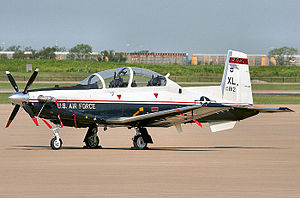Martin-Baker Aircraft Company Limited is a British manufacturer of ejection seats and safety-related equipment for aviation. The company was originally an aircraft manufacturer before becoming a pioneer in the field of ejection seats. The company's headquarters are in Higher Denham, Buckinghamshire, England, with other sites in France, Italy and the United States.

The Beechcraft T-6 Texan II is a single-engine turboprop aircraft built by the Raytheon Aircraft Company. A trainer aircraft based on the Pilatus PC-9, the T-6 replaced the United States Air Force's Cessna T-37B Tweet and the United States Navy's T-34C Turbo Mentor during the 2010s.
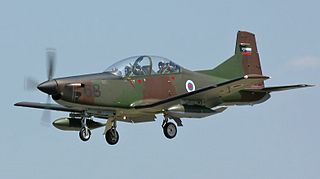
The Pilatus PC-9 is a single-engine, low-wing tandem-seat turboprop training aircraft manufactured by Pilatus Aircraft of Switzerland. Designed as a more powerful evolution of the Pilatus PC-7, the PC-9's first flight was made in May 1984 after which certification was achieved in September 1985. After this, the first production orders for the type were received from the Royal Saudi Air Force, with deliveries commencing in 1985. Since then, more than 250 airframes have been produced across five different variants, and the type is employed by a number of military and civilian operators around the world, including the Swiss Air Force, Croatian Air Force, Royal Thai Air Force and the Irish Air Corps

The Beechcraft T-34 Mentor is an American propeller-driven, single-engined, military trainer aircraft derived from the Beechcraft Model 35 Bonanza. The earlier versions of the T-34, dating from around the late 1940s to the 1950s, were piston-engined. These were eventually succeeded by the upgraded T-34C Turbo-Mentor, powered by a turboprop engine. The T-34 remains in service more than seven decades after it was first designed.
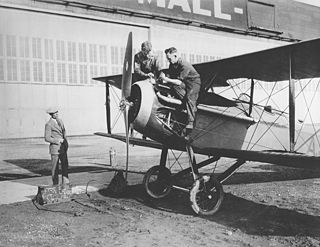
Vought was the name of several related American aerospace firms. These have included, in the past, Lewis and Vought Corporation, Chance Vought, Vought-Sikorsky, LTV Aerospace, Vought Aircraft Companies, and Vought Aircraft Industries.

The North American Sabreliner, later sold as the Rockwell Sabreliner, is an American mid-sized business jet developed by North American Aviation. It was offered to the United States Air Force (USAF) in response to its Utility Trainer Experimental (UTX) program. It was named "Sabreliner" due to the similarity of the wing and tail to North American's F-86 Sabre jet fighter. Military variants, designated T-39 Sabreliner, were used by the USAF, United States Navy (USN), and United States Marine Corps (USMC) after the USAF placed an initial order in 1959. The Sabreliner was also developed into a commercial variant.

The Mid-America Air Museum is an aerospace and aircraft museum located at the Liberal Mid-America Regional Airport in Liberal, Kansas, United States.

The Honduras Air Force is the air force of Honduras. As such it is the air power arm of the Honduras Armed Forces.

KC-X was the United States Air Force (USAF) program to procure its next-generation aerial refueling tanker aircraft to replace some of their older Boeing KC-135 Stratotankers. The contest was for a production contract for 179 new tankers with estimated value of US$35 billion. The two contenders to replace the KC-135 aircraft were Boeing and EADS, following the elimination of US Aerospace, Inc. from the bidding process.
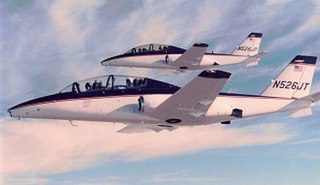
The Cessna 526 CitationJet was a twinjet trainer candidate for the United States Joint Primary Aircraft Training System proposed by Cessna. It was a twin-engined, tandem seat aircraft, based on the Cessna CitationJet executive aircraft. However, it was unsuccessful, with only two prototypes built.
The AN/APG-83 Scalable Agile Beam Radar (SABR) is a full-performance active electronically scanned array fire control radar for the General Dynamics F-16 Fighting Falcon and other aircraft developed by Northrop Grumman. SABR is a multi-function active electronically scanned array (AESA) radar. In a 2013 competition, Lockheed Martin selected SABR as the AESA radar for the F-16 modernization and update programs of the United States Air Force and Republic of China Air Force. 5th Generation Fighter Radar Capability for the 4th Gen Aircraft. The SABR APG-83 is an Active Electronically Scanned Array (AESA) fire control radar.

The Estrella Warbirds Museum is an aviation museum dedicated to the restoration and preservation of military aircraft, vehicles, and memorabilia. The museum is located at Paso Robles Municipal Airport in central California and is named after Estrella Army Airfield. In July, 2009, the museum opened an automobile display featuring classic racing cars, The Woodland Auto Display.
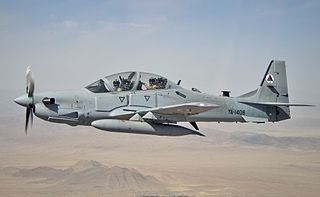
The Light Attack/Armed Reconnaissance (LAAR) or Light Air Support (LAS) program was a United States Air Force program for a new light counter-insurgency, ground attack and reconnaissance aircraft. The aircraft should be capable of finding, tracking, and attacking targets either on its own or in support of ground forces. The program formally began in July 2009 with a request for information. No request for proposal has yet been issued. Approximately 100 aircraft were expected to be ordered, but USAF has reduced the number of aircraft sought to 15 aircraft. The 15 aircraft program was focused at training pilots, not a combat mission. This program has also been called the OA-X program or the AT-X program, although the reduced scope of the LAAR program has forced the USAF to push an "OA-X" program indefinitely into the future. In late 2019, the program received renewed attention by lawmakers, who expressed their frustrations with the program's pace. A group of legislators introduced amendments to the House and Senate versions of the FY 2020 National Defense Authorization Act that would transfer control of the program to the commander of U.S. Special Operations Command.

The T-X program is a United States Air Force development and acquisition program for a new two-seat jet trainer to replace the Northrop T-38 Talon. On 27 September 2018, the US Air Force selected the Boeing/Saab T-X entry to become its trainer aircraft. The new aircraft was given the designation and name "T-7 Red Hawk" in September 2019. The Air Force's initial plan is to purchase 351 T-7s, and has an option to purchase up to 475.

The Long Range Strike Bomber (LRS-B) is a development and acquisition program to develop a long-range strategic bomber for the United States Air Force, intended to be a heavy-payload stealth aircraft capable of delivering thermonuclear weapons. Initial capability is planned for the mid-2020s. A request for proposal to develop the aircraft was issued in July 2014. The Air Force plans to procure at least 100 of the LRS-B aircraft at a cost of an estimated $550 million each, with potentially as many as 200 units being considered to enter service eventually. A development contract was awarded to Northrop Grumman for its B-21 Raider in October 2015. Due to the sensitive nature much about the project is highly classified and little information is available to the public. As of late 2019, it was known that construction of the aircraft had commenced, and on December 2, 2022, it was unveiled to the public.
The Northrop Grumman RQ-180 is an American stealth unmanned aerial vehicle (UAV) surveillance aircraft intended for contested airspace. As of 2019, there had been no images or statements released, but growing evidence points to the existence of the RQ-180 and its use in regular front-line service. The use of the nickname "White Bat" in a 2021 video released by the US Air Force Profession of Arms Center of Excellence (PACE) suggests that the military may be preparing to release information on the RQ-180.
